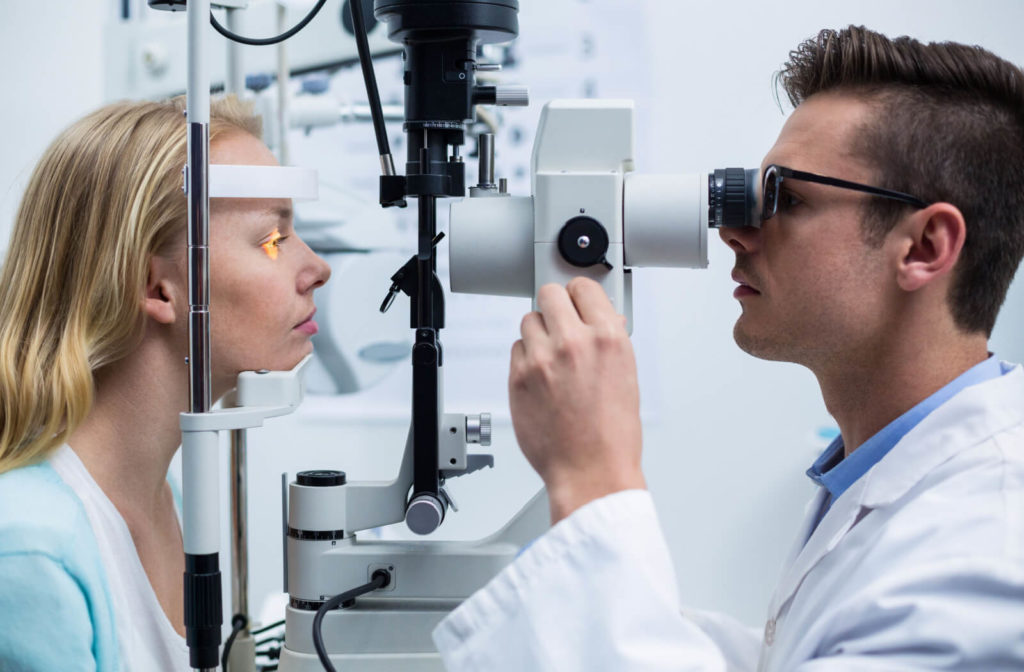Conjunctivitis, typically known as pink eye, is an inflammation or infection of the transparent membrane (conjunctiva) lining your eyelids and covers the white part of your eye. This condition causes redness, itching, and a sensation of grittiness in the eyes, often accompanied by discharge. However, these symptoms are common in other eye conditions, so pink eye is easily misdiagnosed.
Dry eye syndrome, styes, eye allergies, contact lens irritation, and corneal abrasions are frequently misdiagnosed as pink eye. They present similar symptoms, such as redness, itching, and a feeling of grittiness or discomfort in the eyes. It’s crucial to see your eye doctor for a proper diagnosis and appropriate treatment.
Symptoms of Pink Eye
Pink eye is caused by a bacterial or viral infection or an allergic reaction. Symptoms may include:
- Redness in the white of the eye or inner eyelids
- Itching or burning sensation in the eyes
- Excessive tearing or watering of the eyes
- Discharge from one or both eyes, usually accompanied by crusting near the lashes
- Sensitivity to light
These symptoms can range from mild to severe, depending on the cause of the infection. It’s important to pay attention to any changes in your vision or if the symptoms persist for more than a week.
Common Misdiagnosis of Pink Eye
Pink eye is commonly misdiagnosed as other eye conditions.
Dry Eye Syndrome
Dry eye syndrome occurs when your eyes do not produce enough tears or the tears evaporate too quickly, resulting in dryness and irritation. This condition is often mistaken for pink eye due to similar symptoms such as redness, itching, and a gritty feeling in the eyes. However, unlike pink eye, dry eyes are caused by a lack of tears, not an infection.
Allergies
Allergic conjunctivitis (eye allergies) can cause redness, itching, and watering. Although eye allergies are a type of conjunctivitis, they are not contagious and are addressed differently.
Allergies are triggered by an allergen such as pollen or dust.
It can typically be treated by avoiding triggers like pollen or pet dander, using over-the-counter artificial tears, and using antihistamines to alleviate itching and redness.
Contact Lens Irritation
Wearing contact lenses for an extended period or not properly cleaning them can lead to eye irritation and redness, making it easy to mistake for pink eye. However, proper hygiene and contact lens care can help prevent this.
Chalazion or Stye
A stye is a small bump on your eyelid caused by a blockage of one of the glands. It can make your eye look red and swollen, like pink eye. But a stye isn’t contagious.
You can treat it by applying warm compresses to your eyelid. It should help unclog that gland and make the stye go away.
Corneal Abrasion
A corneal abrasion is a scratch on your cornea, the eye’s transparent outer layer. It can cause redness, pain, and sensitivity to light, which are also symptoms of pink eye. However, unlike pink eye, a corneal abrasion is caused by physical damage to the eye rather than an infection.
Often, corneal abrasions heal on their own, but there is a chance they can become infected. If your symptoms persist, it’s important to see your eye doctor.
What Is the Risk of Misdiagnosing Pink Eye?
While pink eye is a common condition that usually heals on its own, misdiagnosing it can have consequences such as:
- Delayed treatment for the actual condition causing the symptoms, leading to potential complications.
- Unnecessary use of antibiotics, which can lead to antibiotic resistance and other adverse effects.
- Spread of contagious infections by not taking the appropriate precautions.
It is crucial to be aware of the differences between pink eye and other similar conditions to avoid these potential risks.
Tips for Accurate Diagnosis
To get an accurate diagnosis of pink eye, here are some tips to keep in mind:
- Observe your symptoms: Take note of the symptoms you are experiencing, such as redness, itching, discharge, and sensitivity to light. This can help your eye doctor make a proper diagnosis.
- Know your medical history: Certain conditions, allergies, or recent use of medications can affect the progression of pink eye. Make sure to inform your eye doctor about any relevant medical information.
- Consider the timing: Pink eye is highly contagious, so if you have recently been in close contact with someone who has it or has been exposed to a potential irritant, such as chlorine in a swimming pool, it is important to mention this to your eye doctor.
- Seek professional help: While home remedies and over-the-counter eye drops may temporarily relieve pink eye symptoms, they do not treat the underlying cause. It is best to consult an optometry center for an accurate diagnosis and treatment.

Prioritize Your Eye Health with Professional Eye Care
Pink eye can be mistaken for other conditions, leading to potential complications and risks. By being aware of the differences between pink eye and other similar conditions, seeking professional help, and following proper precautions, you can get the appropriate diagnosis and effective treatment for your pink eye.
At Golden Hills Optometry now operated by Total Vision, our team can provide comprehensive eye care services, including the appropriate diagnosis and treatment for pink eye. Contact us today to schedule an appointment and get the right eye treatment. Early detection and proper care can help prevent further complications and promote faster recovery.



